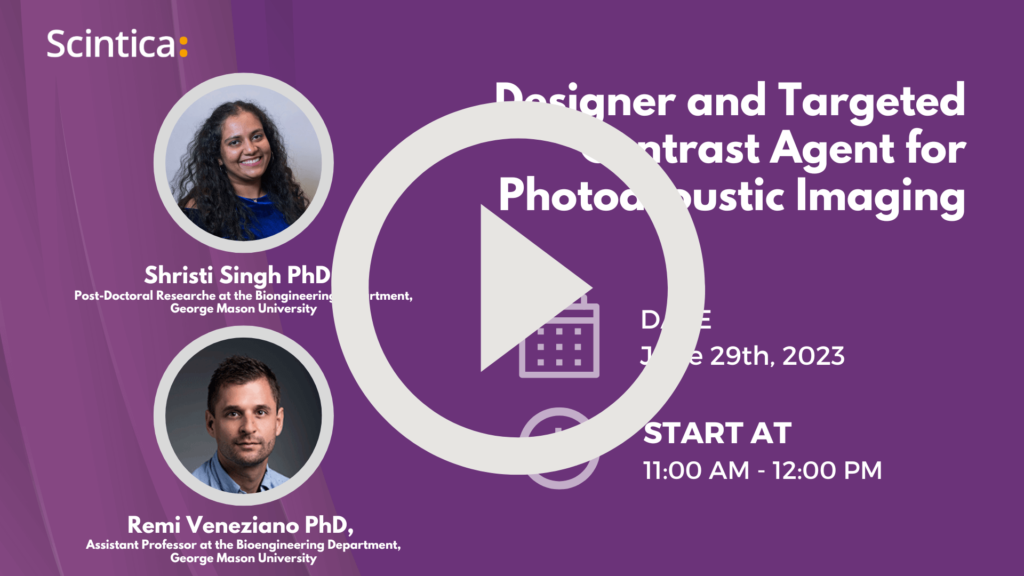(June 29, 2023) Webinar: Designer and Targeted Contrast Agent for Photoacoustic Imaging
Overview:
The talk focused on the synthesis, characterization and use of a novel contrast agent composed of indocyanine green dye for NIR-I photoacoustic (PA) imaging. The contrast agent can be easily tuned to different sizes without enclosure in nanocarriers, has strong optical absorption and PA signal at 895 nm, can be easily functionalized with different targeting molecules and can be imaged for 120 minutes in vivo. The presentation explained details on the genesis of the idea for building a biocompatible contrast agent and give details on its easy synthesis protocols, touch upon a functionalization scheme for adding targeting molecules and demonstrate its use as a PA contrast in mice using the TriTom small animal imaging system.
Photoacoustic imaging (PAI) is a noninvasive imaging modality that relies on absorption of laser light and thermal expansion of biological tissues, which generate ultrasonic waves. These ultrasound waves are then used to reconstitute an image of the tissues with anatomical details and functional information. To increase imaging depth and resolution, PAI requires exogenous molecular contrast agents with high optical absorption in the near infrared (NIR). However, the current repository of NIR dyes that are suitable for PAI is extremely limited. The FDA-approved indocyanine green (ICG) is the only commercially available contrast agent with NIR absorbance that is already used for PAI. However, ICG dyes suffer from poor photostability and high clearance rate.
Under certain conditions, monomeric ICG (with optical absorption peak at 780 nm) self-assembles into brick-like arrangements known as J-aggregates (ICG-JA), which are characterized by a redshift of the absorption peak to 895 nm and a strong photoacoustic signal. These characteristics make ICG-JA promising potential contrast agents for PAI. However, current pre-clinical formulations of ICG-JA require extensive and complex protocols for production. For instance, multiple filtration steps are needed to select nanoscale ICG-JA because of their relative polydispersity. In addition, they also require encapsulation in a nanocarrier for increased stability and addition of targeting molecules.
In this webinar, Dr. Shrishti Singh presented a synthesis method for clinically translatable ICG-JA whose mean size can be finely tuned from 200 nm to 1000 nm and that does not require encapsulation in a nanocarrier. The talk also detailed a complete characterization of the agent and steps for functionalization with targeting peptides or antibodies. Additionally, the webinar also provided details about the PA properties of the contrast in vitro in different conditions including whole blood, followed by details on the photoacoustic imaging in vivo using the TriTom system.
Learning Objectives:
- Get details on the synthesis of a NIR contrast without the need of a nanocarrier.
- Learn in detail about what characteristics a contrast agent should possess to qualify as a clinically translatable technology.
- Become familiar with methods to create a targeted contrast agent.
About the Speaker (s)

Dr. Shrishti Singh
Post Doctoral Researcher, Bioengineering Department at George Mason University
Dr. Shrishti Singh holds a PhD and is currently a Postdoctoral Researcher, both in Bioengineering at George Mason University. Her PhD work has led to the design and synthesis of an imaging contrast agent platform for photoacoustic imaging with ‘bench-to-clinic’ translation capabilities. She is currently pursuing further development of this platform for preclinical and clinical applications with the goal of creating a company around her technology. Dr. Singh is continuously working on the prototype and developing her skills to engage business and healthcare stakeholders.
Project Principal Investigator (PI):

Dr. Remi Veneziano
Post Doctoral Researcher, Bioengineering Department at George Mason University
Dr. Remi Veneziano is an Assistant Professor in the Bioengineering Department at George Mason University. He specializes in “DNA nanotechnology” and in self-assembly of nanoparticles for synthesis of novel delivery platforms that can be used for different biomedical applications such as in rational vaccine design, tissue engineering applications, and biomedical imaging. He was the lead PI on the development of the novel contrast agent platform for photoacoustic imaging that will be presented in the webinar. Other innovations include a DNA Origami vaccine platform allowing for efficient and safe antigen delivery and a DNA-based hydrogel platform with tunable mechanical properties, allowing for controlled release of biomolecules for tissue engineering.
